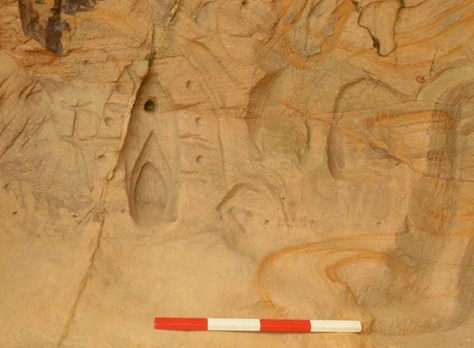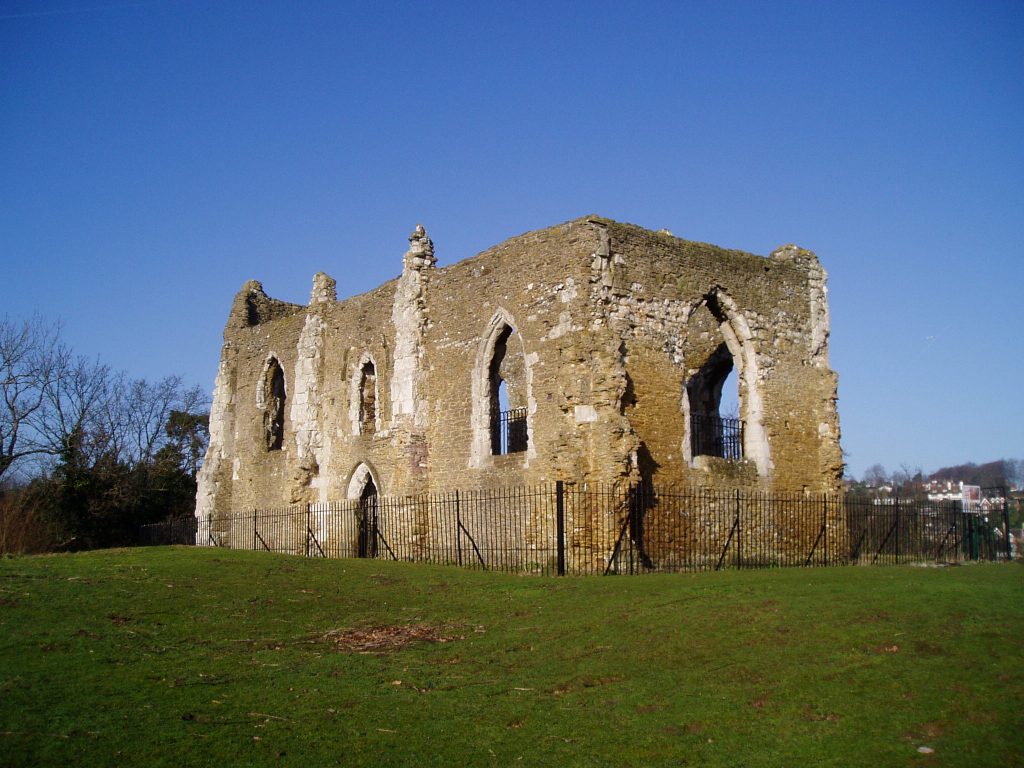 Abraham Lincoln
If given the truth, the people can be depended upon to meet any national crisis...
Abraham Lincoln
If given the truth, the people can be depended upon to meet any national crisis...
 Guildford news...
for Guildford people, brought to you by Guildford reporters - Guildford's own news service
Guildford news...
for Guildford people, brought to you by Guildford reporters - Guildford's own news service
Mystery of St Catherine’s Hill Continues, Cave Talk Reveals Sparse New Evidence
Published on: 7 Mar, 2021
Updated on: 8 Mar, 2021
By Dr Mary Alexander
Highlight of the Surrey Archaeological Society’s annual symposium on recent excavations was about the mysterious cave on St Catherine’s Hill, found by Network Rail last year during repairs on a collapse near the railway tunnel.
This revealed probably the most interesting discovery around Guildford for a century or more.
On Zoom, Michael Shapland, of Archaeology South East, told how he excavated the cave and described his fascinating findings. Religious symbols had been scratched into the sandstone walls, suggesting it was a religious shrine.
Dr Shapland interprets the site in what could be called a maximalist way, seeing the hill as a special place, attracting people for a variety of reasons. The earlier name was Drake Hill, meaning “dragon hill” [incidentally, the origin of the name The Guildford Dragon NEWS, Ed].

The discovered cave, apparently truncated when the railway tunnel entrance below was cut in the mid 19th century. Soot deposit samples taken during the excavation still await carbon dating.
Although I would love St Catherine’s to have been a special place, I also prefer to be cautious and see the hill in a more minimalist way, using the facts we have. Even if local people believed a dragon lived in the hill, this doesn’t mean very much. There was no cult of dragons.
There is a handful of stray finds from the hill, but not enough to prove it was a place where people regularly congregated. In fact, metal detector finds show very little of interest, even from the fair, which ended in 1915.
Dr Shapland suggests the hill was a meeting place for the three hundreds (administrative units) whose boundaries met at Guildford but there is no proof of this, though the hill would make a good meeting-place.
I prefer to see the chapel as being built by the rector of St Nicholas at a place where natural routes crossed, the road between Portsmouth and London, and the more local track along the sand at the foot of the chalk.
The chapel may have been an excuse to apply for a licence to hold an annual fair, which could bring in lots of money. The chapel may have also attracted a hermit who lived in the cave, or used it as a retreat. He could even have been the priest of the chapel. Hermits were supported by alms, and there were plenty of passers-by.
Hermits often lived by bridges or ferries and a hermit at St Catherine’s could well have operated a ferry over the river. I believe in Saxon times the river there was moved west and embanked times to provide a head of water for their own mill. Certainly, that was done well before the Godalming Navigation was built.
In 1376, a bridge was built over the river and immediately pulled down again. The builders said there had always been a bridge, the demolishers said there had never been one.
An odd story, but there was a ferry, at least later, because there had to be some way of getting across the river.
The discovery of the cave proves St Catherine’s chapel was a significant feature in the medieval religious landscape.
See Dr Shapland’s talk here…
And Mark Insoll’s film shot last spring here…
Responses to Mystery of St Catherine’s Hill Continues, Cave Talk Reveals Sparse New Evidence
Leave a Comment Cancel reply
Please see our comments policy. All comments are moderated and may take time to appear. Full names, or at least initial and surname, must be given.
Click on cartoon for Dragon story: Public Asked for Views on SCC’s Proposal for Reduced Speed Limits


Recent Articles
- Frimley Park at the Beginning of the Hospital Rebuild Queue
- Letter: Council Has Quietly Relieved Developer of £Million Obligation
- The Royal Surrey Hospital to Open Its Doors to the Public for Community Open Day
- Summary of GBC Planning Decisions – June 18, 2025
- Letter: Reflecting on the Juneja Case Shows the Importance of the Monitoring Officer Role
- New Electric Trains Now Arriving at Guildford – 100 Years After the First One Did
- Woman Pedestrian Dies on A31 After Collision With a Truck
- A281 Closure – Latest Report Says The Street To Be Re-opened
- Road Closed After Lorry Hits Railway Bridge
- The Bishop’s Leap of Faith – From the Top of the Cathedral


Recent Comments
- H Trevor Jones on Residents Urged to Have Their Say on the Changing Shape of Surrey’s Local Government
- Alistair Smith on A281 Closure – Latest Report Says The Street To Be Re-opened
- Roland Dunster on GBC’s Plan For a Thriving Guildford ‘Is Our Promise to Residents’ Says Council Leader
- Richard Benson on GBC’s Plan For a Thriving Guildford ‘Is Our Promise to Residents’ Says Council Leader
- Nigel Base on Letter: Recreational Rowing Might Be the Answer
- Anna Windebank on GBC’s Plan For a Thriving Guildford ‘Is Our Promise to Residents’ Says Council Leader
Search in Site
Media Gallery
Dragon Interview: Local Artist Leaves Her Mark At One of England’s Most Historic Buildings
January 21, 2023 / No Comment / Read MoreDragon Interview: Lib Dem Planning Chair: ‘Current Policy Doesn’t Work for Local People’
January 19, 2023 / No Comment / Read MoreA3 Tunnel in Guildford ‘Necessary’ for New Homes, Says Guildford’s MP
January 10, 2023 / No Comment / Read More‘Madness’ for London Road Scheme to Go Ahead Against ‘Huge Opposition’, Says SCC Leader
January 6, 2023 / No Comment / Read MoreCouncillor’s Son Starts Campaign for More Consultation on North Street Plan
December 30, 2022 / No Comment / Read MoreCounty Council Climbs Down Over London Road Works – Further ‘Engagement’ Period Announced
December 14, 2022 / No Comment / Read MoreDragon Interview: GBC Reaction to the Government’s Expected Decision to Relax Housing Targets
December 7, 2022 / No Comment / Read MoreHow Can Our Town Centre Businesses Recover? Watch the Shop Front Debate
May 18, 2020 / No Comment / Read More








Stuart Barnes
March 8, 2021 at 9:25 am
Absolutely fascinating.